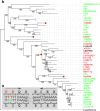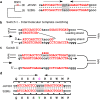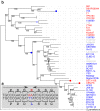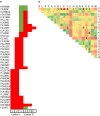Protein innovation through template switching in the Saccharomyces cerevisiae lineage
- PMID: 34799587
- PMCID: PMC8604942
- DOI: 10.1038/s41598-021-01736-y
Protein innovation through template switching in the Saccharomyces cerevisiae lineage
Abstract
DNA polymerase template switching between short, non-identical inverted repeats (IRs) is a genetic mechanism that leads to the homogenization of IR arms and to IR spacer inversion, which cause multinucleotide mutations (MNMs). It is unknown if and how template switching affects gene evolution. In this study, we performed a phylogenetic analysis to determine the effect of template switching between IR arms on coding DNA of Saccharomyces cerevisiae. To achieve this, perfect IRs that co-occurred with MNMs between a strain and its parental node were identified in S. cerevisiae strains. We determined that template switching introduced MNMs into 39 protein-coding genes through S. cerevisiae evolution, resulting in both arm homogenization and inversion of the IR spacer. These events in turn resulted in nonsynonymous substitutions and up to five neighboring amino acid replacements in a single gene. The study demonstrates that template switching is a powerful generator of multiple substitutions within codons. Additionally, some template switching events occurred more than once during S. cerevisiae evolution. Our findings suggest that template switching constitutes a general mutagenic mechanism that results in both nonsynonymous substitutions and parallel evolution, which are traditionally considered as evidence for positive selection, without the need for adaptive explanations.
© 2021. The Author(s).
Conflict of interest statement
The authors declare no competing interests.
Figures






Similar articles
-
Whole Genome Sequence Analysis of Mutations Accumulated in rad27Δ Yeast Strains with Defects in the Processing of Okazaki Fragments Indicates Template-Switching Events.G3 (Bethesda). 2017 Nov 6;7(11):3775-3787. doi: 10.1534/g3.117.300262. G3 (Bethesda). 2017. PMID: 28974572 Free PMC article.
-
Mating-type switching by chromosomal inversion in methylotrophic yeasts suggests an origin for the three-locus Saccharomyces cerevisiae system.Proc Natl Acad Sci U S A. 2014 Nov 11;111(45):E4851-8. doi: 10.1073/pnas.1416014111. Epub 2014 Oct 27. Proc Natl Acad Sci U S A. 2014. PMID: 25349420 Free PMC article.
-
Template switching during DNA replication is a prevalent source of adaptive gene amplification.Elife. 2025 Feb 3;13:RP98934. doi: 10.7554/eLife.98934. Elife. 2025. PMID: 39899365 Free PMC article.
-
DNA protein interactions at the rRNA of Saccharomyces cerevisiae.Ital J Biochem. 2007 Jun;56(2):81-90. Ital J Biochem. 2007. PMID: 17722648 Review.
-
The RAD6 DNA repair pathway in Saccharomyces cerevisiae: what does it do, and how does it do it?Bioessays. 1994 Apr;16(4):253-8. doi: 10.1002/bies.950160408. Bioessays. 1994. PMID: 8031302 Review.
Cited by
-
Targeted accurate RNA consensus sequencing (tARC-seq) reveals mechanisms of replication error affecting SARS-CoV-2 divergence.Nat Microbiol. 2024 May;9(5):1382-1392. doi: 10.1038/s41564-024-01655-4. Epub 2024 Apr 22. Nat Microbiol. 2024. PMID: 38649410 Free PMC article.
-
Spontaneous and environment induced genomic alterations in yeast model.Cell Insight. 2024 Sep 26;4(1):100209. doi: 10.1016/j.cellin.2024.100209. eCollection 2025 Feb. Cell Insight. 2024. PMID: 39629481 Free PMC article. Review.
References
Publication types
MeSH terms
Substances
Grants and funding
LinkOut - more resources
Full Text Sources
Molecular Biology Databases

